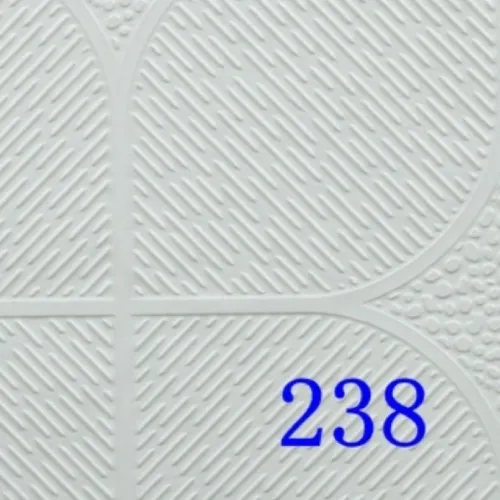- Afrikaans
- Albanian
- Amharic
- Arabic
- Armenian
- Azerbaijani
- Basque
- Belarusian
- Bengali
- Bosnian
- Bulgarian
- Catalan
- Cebuano
- Corsican
- Croatian
- Czech
- Danish
- Dutch
- English
- Esperanto
- Estonian
- French
- German
- Greek
- Hindi
- Indonesian
- irish
- Italian
- Japanese
- Korean
- Lao
- Malay
- Myanmar
- Norwegian
- Norwegian
- Polish
- Portuguese
- Romanian
- Russian
- Serbian
- Spanish
- Swedish
- Thai
- Turkish
- Ukrainian
- Uzbek
- Vietnamese
12월 . 25, 2024 11:24 Back to list
false ceiling access panel
Understanding False Ceiling Access Panels An Essential Guide
In modern architecture and interior design, false ceilings have become increasingly popular due to their aesthetic appeal and functional benefits. These ceilings, also known as dropped or suspended ceilings, are installed below the actual ceiling structure, creating a space that can be utilized effectively for various purposes. One integral component of false ceilings is access panels, which play a crucial role in maintenance and serviceability. In this article, we will explore the importance of false ceiling access panels, their types, applications, and installation considerations.
What are False Ceiling Access Panels?
False ceiling access panels are openings within a suspended ceiling that provide access to the space above it. This space is often used for electrical wiring, plumbing, HVAC systems, and other critical infrastructure. Access panels can be easily opened and closed, allowing maintenance personnel to reach the above-ceiling area without having to dismantle large sections of the false ceiling. This accessibility is essential for routine checks, repairs, and installations.
Importance of Access Panels
1. Maintenance Convenience One of the primary reasons for incorporating access panels into false ceilings is the convenience they provide for maintenance activities. Regular inspections of electrical and HVAC systems are crucial for safety and efficiency. Access panels allow technicians to perform these checks without disrupting the entire ceiling.
2. Aesthetic Continuity Access panels are available in various designs and finishes that can match the false ceiling, ensuring that they blend seamlessly with the overall aesthetic. This means that while functionality is prioritized, the visual appeal of the space is not compromised.
3. Cost Efficiency By enabling quick access to the infrastructure above the ceiling, access panels help reduce the time and labor costs associated with maintenance. This efficiency can lead to significant cost savings for building owners over time.
Types of False Ceiling Access Panels
Access panels come in several types, each suited for different applications
1. Standard Access Panels These are the most common type, providing basic access to the ceiling cavity. They typically feature a simple hinged door that swings open.
false ceiling access panel

2. Fire-Rated Access Panels In fire-sensitive areas, fire-rated access panels are essential. These panels are designed to prevent the spread of fire and must meet specific regulatory standards.
3. Acoustic Access Panels These panels are specially designed to minimize sound transmission, making them ideal for environments like recording studios or conference rooms where noise control is paramount.
4. Security Access Panels For sensitive areas that require higher security, these access panels feature locking mechanisms to prevent unauthorized access.
Installation Considerations
When installing access panels in a false ceiling, several factors must be taken into account
1. Location The placement of access panels should be strategic to ensure that they provide easy access to all necessary infrastructure without compromising the design of the space.
2. Size The size of the access panel should be appropriate for the equipment or maintenance tasks it needs to accommodate. A small panel may not provide sufficient access, whereas an overly large panel can be visually intrusive.
3. Sealing and Insulation Proper sealing is essential to maintain the acoustic and thermal integrity of the ceiling. Access panels should be installed in a way that minimizes any disruption to the existing insulation or soundproofing.
4. Compliance with Building Codes It is crucial to ensure that the installation of access panels adheres to local building codes and regulations. This compliance ensures safety and can help avoid costly penalties during inspections.
Conclusion
False ceiling access panels are a vital component in modern architectural design, enhancing both functionality and aesthetics. Their role in facilitating maintenance, improving safety, and offering cost efficiencies cannot be overstated. By understanding the types of access panels available and the important considerations for their installation, building owners and designers can make informed decisions that contribute to the overall success of their projects. As urban environments continue to evolve, the significance of features like false ceiling access panels will undoubtedly grow, reflecting the ongoing need for balance between design, functionality, and accessibility.
-
Transform Interiors with PVC Gypsum Ceiling: A Stylish, Durable, and Moisture-Resistant SolutionNewsMay.19,2025
-
The Smart Interior Upgrade: Discover the Durability and Versatility of Gypsum Ceiling Access Panel SolutionsNewsMay.19,2025
-
The Smart Choice for Interior Design: Discover the Value of PVC Gypsum Ceiling SolutionsNewsMay.19,2025
-
Mineral Fiber Ceiling Tiles: The Smart Blend of Performance and AestheticsNewsMay.19,2025
-
Mineral Fiber Ceiling Tiles: The Superior Choice Over Gypsum for Sound and Fire SafetyNewsMay.19,2025
-
Mineral Fiber Ceiling Tiles: Eco-Friendly Strength and Style for Every CeilingNewsMay.19,2025







